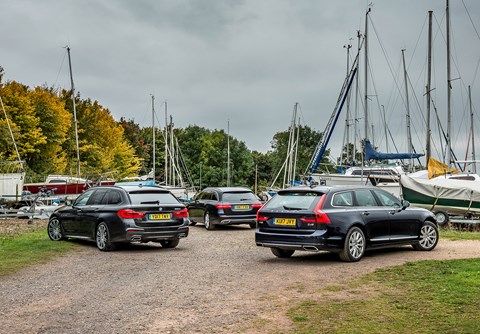► Premium executive estate review
► New 5-series battles E-class, V90
► Which posh wagon would you pick?
History suggests that those in power rarely remain there for long if they do nothing. When you’re as dominant as the Germans are in the premium estate market, the temptation to do nothing must be very strong. To ensure they’re not letting the opposition sneak an advantage they don’t exactly do nothing, but instead they take a very conservative, entirely evolutionary approach to developing their class-defining wagons.
And then along comes Volvo with the rather artfully wrought V90, which could easily make the latest E-Class (new last year) and 5-series (new this year) seem less innovative than they actually are. While they mither over minutiae in Munich and scrabble for design traction in Stuttgart, the good burghers of Gothenburg have simply gone for it…
We need to find out whether the game really has been changed by the arrival of the Volvo, or whether the Merc and BMW – however familiar – still deserve to be the default choices.
Executive estate prices: the cost of family wagon duties
BMW’s latest take on its 5-series Touring, in £41,120 520d M Sport guise, takes on Mercedes’ £38,655 E220d SE Estate and the £43,115 Volvo V90 D4 Inscription.
Externally, disparities are not obvious; these are all handsome machines. The BMW in particular is properly svelte. The E-Class actually benefits from something called styling these days, even if the added swoopiness at the rear end does marginally diminish a load capacity traditionally on a par with Jonah’s whale (and even if I did find its predecessor better looking).
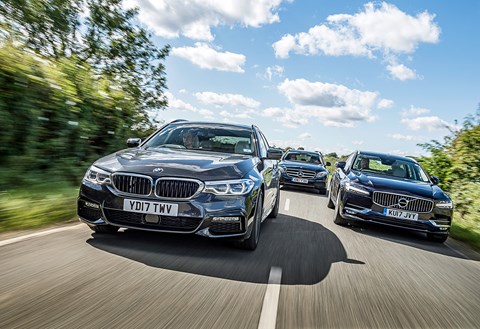
And the Volvo, once immortalised by Dudley Moore’s over-honest advertising creative in the film Crazy People as ‘Boxy, but Good’, has become entirely striking; my only concerns being inappropriately truck-like vertical front grille bars, and – tailgate raised – dangerously vulnerable rear lamp cluster inner elbows.
On board, however, every pixel tells a different story…
Interiors and cabin quality
BMW has been in a state of flux with its cabin styling ever since former design chief Chris Bangle’s insistence that ‘BMW has to change’ led to an ergonomic free-for-all of a 7-series interior, eliciting the almost universal riposte ‘Why?’.
Endless extras pushing its price to a puckering £54,315, this 520d’s is, indubitably, a beautifully crafted interior, with painstaking attention to detail everywhere you look. But the clunky, horizontal emphasis of the centre console originally informed by the chromed land yachts among which Bangle spent his Wisconsin childhood remains, albeit now slowly angling back towards the driver with each evolution.
Central air vents set low because of the dash-top 10.25-inch screen’s positioning may have your nipples exploding with happiness on a warm day, but make the facial acquisition of cool air less easy.
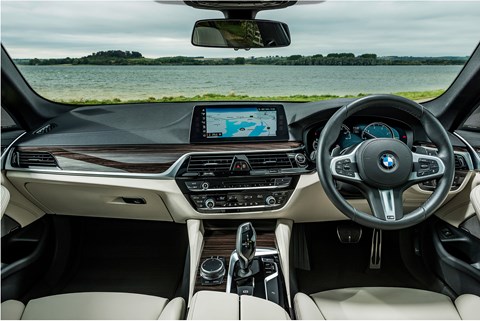
The ultimate on-screen flexibility of the faux analogue LED instrument binnacle is badly shackled by the addition of real dial surround trim stuck onto the screen surface, thus locking all four dials into one position in perpetuity.
Unlike the Wal-Mart-customer-girth steering wheel rim of BMW M cars, this rim remains thin enough for you to have a fighting chance of getting your fingers properly around it. But tactility is still marred by the big blisters on the inner rim right where you would wish to hold the helm. And the huge Display Key is just that; something you can dangle overtly while sipping your isotonic drink at the bar in the gym.
On a more positive note, the once baffling iDrive infotainment control system has become increasingly easy to use through several generations of refinement and shouting ‘NO’ at engineers, even if some controls remain buried park-up-to-find-it deep within sub-menus.
The front seats are comfortable and the driving position is first class. There’s plenty of legroom in the back between knee cap and scalloped seat back. But the 40:20:40 split rear seats are very upright, and decidedly firm – even harder to sink into than a James Joyce novel.
More BMW reviews by CAR magazine
Boot space, dimensions, please…
Its volume ranging from 570 to 1700 litres, the clever loadspace boasts a powered tailgate, automatically retracting luggage cover, and sidewall-mounted switchgear for the collapse of the rear seats and the deployment of the automatic tow hook.
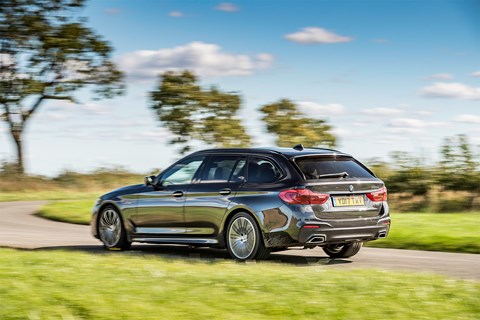
Part of the luggage cover, a cargo net can be extended to the ceiling to prevent the mauling of passengers by the load or the larger pet. The cover ’n’ net combo may be demounted and stored under the floor to offer a completely clear loadspace without recourse to your shed. Sadly, despite all this ingenuity, you have to switch off the engine before you can open the tailgate.
Absolutely the very best thing about this interior, though, is that BMW has finally fired the electronic indicators and gone back to a good old mechanical stalk, which stays where you put it. Hoo and indeed rah…
Inside the Mercedes E-class Estate’s cabin
Nearly 10 grand’s worth of optional goodies pushing the price to £48,285, the Mercedes cabin, meanwhile, suggests a company apparently struggling with the issue of keeping an existing and gently aged customer base happy while still managing to attract new clientele.
For the former, we have traditional chrome trim brought up to date with the aid of a wire brush, switchgear clustered into smiley panels of the type that Renault has recently, and mercifully, shed, and ruthlessly over-detailed elements such as the Burmester stereo’s speaker grilles. Even the engine stop/start button has been styled to within an inch of its life.
For the latter, we have twin 12.3-inch screens forming an instrument binnacle that yawns out across more than half the dashboard, reminding us why early television sets were encased in simulated teak veneer cabinets, with doors, to disguise the cabin charisma black hole that is a blank screen the size of the piping-hot stone awarded you by restaurants which can’t be bothered to cook your steak.
All our Mercedes-Benz reviews
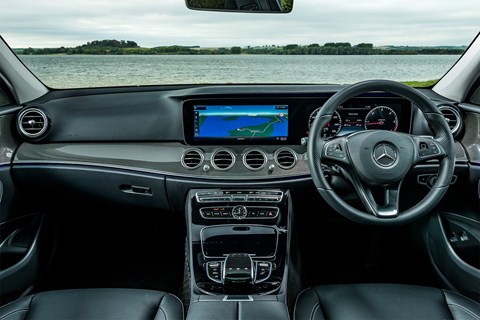
The infotainment system is largely the one we already know and love, with a couple of important backward strides. Mercedes’ new swipe ’n’ hope steering wheel switchgear is far more fiddly and far less intuitive than that which it replaces, and putting a touch-sensitive pad directly over the knob controlling the infotainment system remains fraught with the danger of inadvertent commands.
There is, however, no arguing with sublimely comfortable front seats and a fine driving position. Rear accommodation is also by far the most cosseting in this group, with seatbacks set at less Victorian angle than those of the BMW, and upholstery boasting pleasing degrees of give.
A loadspace volume of between 640 and 1820 litres shares the powered attributes of the BMW, and its ability to collapse 40:20:40 split rear seats from wall-mounted switchgear. A second, underfloor compartment stores a cargo net, a collapsible shopping crate allowing your purchases to slosh to and fro as one, and a can of foaming goo for the temporary resurrection of flat tyres.
There’s a powered tow hook here too. Unlike the BMW’s, which oozes from behind the bumper like the Creature emerging from his Black Lagoon, the Merc’s rises to the occasion with sufficient vim to conjure fond memories of a distant youth.
The Volvo V90 in detail
And so to the Volvo, its ticked options tickling the price up a relatively modest three and half grand to £46,690. Time was when the company found itself shackled by a somewhat folk-weave-knickers desire to reinforce its Swedish heritage through the use of materials you’d not find anywhere else in the industry.
Happily, however, the days of diced moose spore dashboards and nettle-dyed upholstery are long gone, to be replaced by the sort of crisp, clean, ergonomically superior interior design for which Swedes have long been famous. With, in this case, added comfort. This really is a lovely environment.
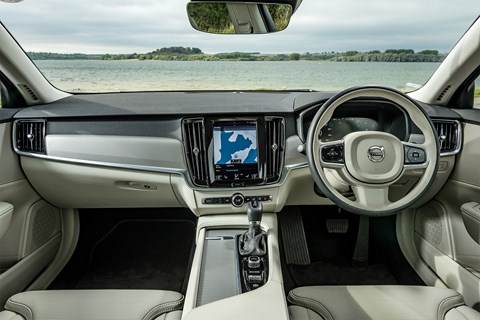
Some have suggested that the faux analogue instrument binnacle could do more, but all the driving information required is on display, and if you want to watch a seal balancing a beach ball on its nose, go to the circus.
The piano black steering wheel switchgear takes a little learning but is largely straightforward to use. And the various finishes are generally splendid, save the beaten pewter look to the engine start and driving dynamics switchgear, and the steering column-mounted stalks, which are of a rough-looking, woefully non-tactile plastic finish right up there with the
‘surprise’ in a Kinder egg in the quality stakes.
Volvo car reviews: every road test by CAR magazine
The V90’s finest attribute, however, is perhaps the best iteration of touchscreen multimedia technology yet to grace a car interior. So absolute is the power that it wields that the remaining adjacent switchgear is limited to basic stereo controls and, sensibly, front and rear screen demist buttons.
This flick ’n’ pinch, nine-inch tablet-style system not only stacks up secondary information which remains visible beneath the main screen at all times, but has also been designed by a sufficiently human being to add several neat touches, such as a ‘Set destination’ tab which appears at the base of the map, obviating the curse-laden quest for related menus.
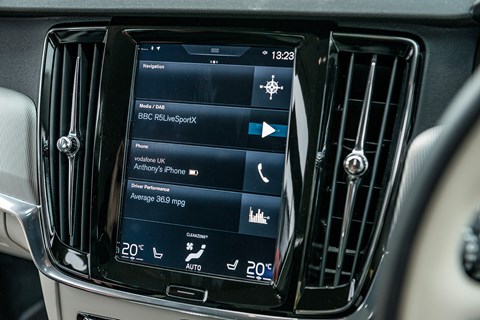
And that map is in portrait format to boot, thus displaying places you’ll visit en route, rather than those you will not.
The front seats are ergonomically superb, and the 60:40 split/folding rear seat accommodation, though not quite as cosseting as that of the Mercedes, is generous in every department except under the front seats, where winkle-pickers alone can penetrate the narrow slot left by the electrics.
A loadspace offering between 560 and 1526 litres of volume shares all the attributes of the BMW and Mercedes bar the tow hook, and adds a space saver under the floor and, just inside the tailgate, a clever little lift-up panel with elastic strapping that will secure a couple of shopping bags, thus preventing vigorous driving from starting the omelette-making process before you actually reach the kitchen.
Safety specs and nannying devices
Now, before we pull out of the car park, it’s worth mentioning that the owner of any one of these three estates will find themselves, to a greater or lesser extent, having to negotiate a burgeoning raft of safety systems which must be deactivated before anything approaching a normal driving experience becomes available.
I spent a small but prickly eternity surfing menus in the 5-series in order to deactivate a lane departure system which rudely yanks the wheel from you when you’re gleefully straightening a B-road. I’ve spent more layby time de-TRONICing diverse Mercedes only to find that the distance control system doesn’t actually have an ‘off’ setting.
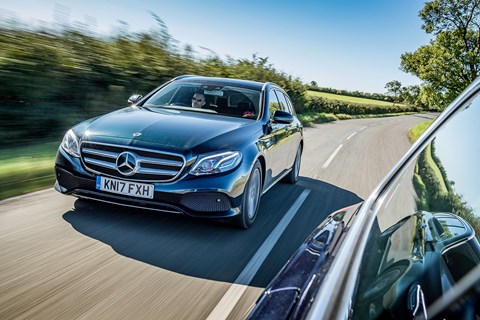
The Volvo, meanwhile, wouldn’t even let me inch the car around for static photography unless I fastened the seatbelt. Happily, however, one swipe of that touchscreen gives you access to the entire list of driving assistants and nannies in icon form, after which an ecstasy of stabbing familiar only to the likes of Julius Caesar will unburden your driving of same.
‘It’s not the customer’s job to figure out what they want,’ Apple’s Steve Jobs once said. Nope, in the case of the automotive industry it’s the customer’s job to figure out how the hell to switch off what they don’t want…
Farewell, the six pot…
Under all three bonnets lurk examples of that paragon of middle-of-the-road performance for which the phrase hum-drum must surely have been coined to describe it at idle, the four-cylinder, 2.0-litre turbodiesel.
Both 5-series and V90 develop 187bhp, while the E-Class musters 191bhp, and all three generate 295lb ft of torque, with little to choose between them in terms of straight-line performance. They are all smooth, quiet and effortless when it comes to inhaling motorway miles.
Traditionally, you’d expect a 2.0 diesel to have a powerband too narrow, and a soundtrack too unappealing, for it to encourage bouts of lead foot. Yet mating these units to utterly oleaginous gearboxes boasting more cogs than a Spirograph set, and lobbing in Sport modes and – in the case of the 5-series and E-Class – flappy paddles has managed to unearth an adequate turn of speed and just a whiff of entertainment.
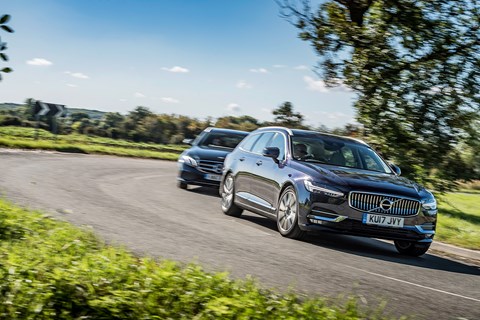
The E-Class’s engine is far quieter than the unit it replaces. In Sport mode with paddles to hand, changes between the gears – all nine of them – are switch-click fast yet so smooth the rev counter remains the only record of their occurrence. The ride quality’s so good that progress is invariably swifter than you suspect and sufficiently isolating from the road surface to remove almost all the gristle from the blancmange.
The steering’s nicely weighted and pleasingly accurate but any attempts to hustle, with their attendant rapid changes in direction, tend to elicit a fair degree of body movement, understeer in the bows and vomit astern. Thank the fundamentally relaxed attitude of the undercarriage.
The Volvo V90: what’s it like to drive?
There’s an underlying firmness to the V90’s suspension, most noticeable as it thumps over car park sleeping anacondas. It doesn’t float quite so much over crests as the E-Class, and there’s more road surface information coming through the seat of the pants, but certainly not the helm.
The steering is the Volvo’s worst dynamic attribute; it’s disturbingly elastic in feel, and numb at top dead centre. This makes the car feel reluctant to turn in with any real alacrity and, though it evinces more outright grip than the E-Class, it never presents as a car that wishes to be thrown around.
The absence of flappy paddles here serves as appropriate recognition of this. The selection of Dynamic mode brings faster gearchanges and higher revs in each of them, a faster throttle response and added steering weight (read, a tighter elastic band), but equally brings no desire to take greater control over the powertrain.
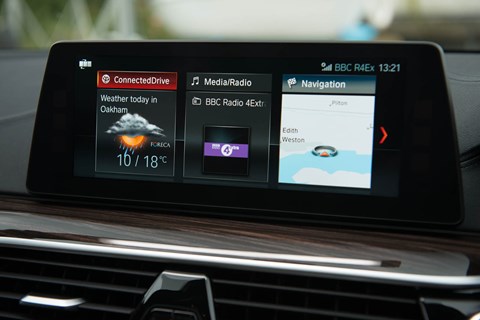
All of which, despite its gently over-slushy approach to gearchanges, leaves the 5-series as the finest, most sophisticated drive here. Ride quality is sublime; even in Sport mode there’s a suppleness and subtlety to progress at any speed.
Happily, there’s an Adaptive setting for the dampers which, taking data from your inputs, the road surface and the sat-nav’s take on the road ahead, works so well that the only reason to engage Sport mode is to sharpen the throttle and gearchange responses. A good reason…
Accurate, well-weighted steering tingles pleasingly with road surface information, and the nose responds to inputs with an immediacy and involvement lacking in both E-Class and V90. This promotes smooth yet lithe and agile progress that utterly belies the size of the car. If ever a machine merited stronger engine performance, it’s this.
Verdict
So, as you will have discerned, you have to nit-pick pretty assiduously to find fault with any of these three admirable machines.
As ever when dealing with cars of this quality and class, each boasts attributes its rivals can only envy and admire. The E-Class has had mastery of long-haul cosseting stamped into its genes for generations, and continues that tradition in fine style here.
While the German duo maintain the even strain of painstaking evolution, the V90 smacks of a far more dramatic, revolutionary approach – particularly within the cabin – with which, on this showing, it is hard to argue.
However, not just because they’ve finally fixed the ruddy indicators but, rather, because CAR is, ultimately, all about the sheer pleasure of driving, the quietly marvellous 5-series Touring simply will not be ignored.
More comparison tests by CAR magazine
